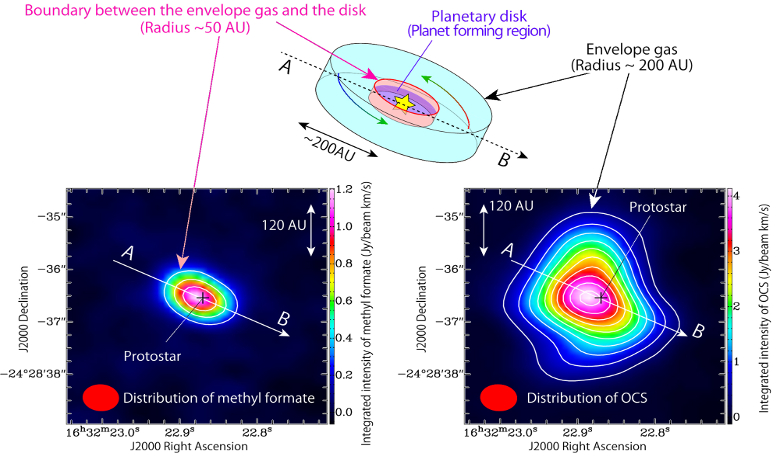A massive rotating ring of organic molecules, with a radius 50 times wider than the Earth’s orbit, has been detected around a Solar-type protostar, showing that interstellar organic materials are being fed into a rotating disk structure that eventually forms a planetary system.
Using the high spatial resolution capabilities of the Atacama Large Millimeter/submillimeter Array (ALMA), an international team led by Yoko Oya, a graduate student from the Department of Physics at the University of Tokyo, and Nami Sakai, an associate chief scientist of RIKEN studied the distribution of a number of organic molecules including methyl formate (HCOOCH3) and carbonyl sulfide (OCS) around IRAS 16293-2422A. The ring structure round 16293-2422A is comparable to the size of the Solar System (~50 AU), and it most likely represents the boundary region between the outer envelope of gas – that extends over a 200 AU scale – and an inner rotating disk structure around the protostar.
By analysing rotational spectral line emission from two specific molecules, methyl formate (HCOOCH3) and carbonyl sulfide (OCS), the team were able to show that the distribution of methyl formate is confined in a more compact area around the protostar, while the OCS distribution mainly traced the infalling gas from the surrounding rotating envelope. “When we measured the motion of the gas containing methyl formate by using the Doppler effect,” said Oya, “we found a clear rotation motion specific to the ring structure.”
It has long been postulated that organic molecules like methanol (CH3OH) form in diffuse gas clouds floating between stars which are then preserved on the surfaces of dust grains. Molecules may then be liberated from ice mantles by weak accretion shocks or by protostellar heating from the nascent star. However, due to the compact nature of the molecular emission, the transition of these compounds from envelope to disc has evaded previous radio telescope observations. Now, with telescopes such as ALMA it has been possible to show these organic molecules being brought into the planet-forming region.
These results build on previous observations of a system known as L1527, whereby a similar ring structure of SO (sulfur monoxide) was detected around another Solar-type protostar. In this source, SO preferentially exists in the boundary between the infalling gas and the disk structure, while unsaturated complex organic molecules such as CCH and cyclic-C3H2 are very abundant in the infalling gas. Although comparisons between the physical structure of the two systems can be made, their chemical composition is much different, thus highlighting that the molecular species brought into the planet-forming region vary from one protostar to another, as it expected that saturated complex organic molecules are almost completely absent in L1527.











